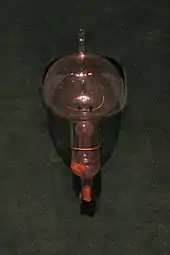Edison light bulb
Edison light bulbs, retroactively referred to as antique light bulbs, and vintage light bulbs, refer to carbon- or early tungsten-filament incandescent lamps, or modern bulbs reproducing their appearance. Most of these bulbs are reproductions of the wound filament bulbs made popular by Edison Electric Light Company at the turn of the 20th century. They are easily identified by the long and complicated windings of their internal filaments, and by the very warm-yellow glow of the light they produce (many of the bulbs emit light at a color temperature of 2200–2400K).
History

Light bulbs with a carbon filament were first demonstrated by Joseph Swan in February 1879, and by Edison in October 1879.[1][2] Carbon filament bulbs, the first electric light bulbs, became available commercially in 1879.[3] In 1904 a tungsten filament was invented by Austro-Hungarians Alexander Just and Franjo Hanaman,[4] and was more efficient and longer-lasting than the carbonized bamboo filament used previously.[5] The introduction of a neutral gas to the glass envelope (or bulb) also helped to improve lifespan and brightness of the bulb.[5] To produce enough light, these lamps required the use of extremely long filaments, and remained so until the development of more efficiently wound tungsten filaments.
Resurgence

While the intricate filament design never fully left, innovations in energy efficiency outpaced the highly inefficient design quickly. Still, 51 years after more efficient designs had come into play, "Edison-style" or vintage lights saw resurgence in many businesses and homes wanting atmospheric lighting or vintage themes.[6]
Reproductions of the antique bulbs began in the 1980s by Bob Rosenzweig.[6] He began selling the vintage-style light bulbs after watching a salvage operation.[6] The reproductions were sold mostly to collectors and prop houses until the turn of the 21st century, when new regulations banned low-efficiency lighting in many countries. Domestic lighting shifted toward more efficient compact fluorescent lamps and LED lights, but demand for vintage bulbs also increased.[6] Edison-style light bulbs are exempted from the ban in most places as "specialty lighting".
Modern "Edison light bulbs" are designed to replicate the same light color and bulb shape to offer a more energy-efficient version of the popular vintage reproduction bulbs. (Modern tungsten coils are already more efficient.[5][7][8]) These bulbs also maintain the same "exposed" look to further preserve the vintage reproduction style,[9] and often employ the "ST" long-pear bulb shape for the same reason. LED filament bulbs have multiple light-emitting filaments within the glass lens, reminiscent of, though not always identical to, antique bulbs. LED bulbs, including LED filament types, are much more energy-efficient than any incandescent lighting.[10]
US inventor Robert (Bob) Kyp patented light bulbs under the name Balafire,[11] and radiometers; the company he ran since 1964, Kyp-Go,[12] is the only US manufacturer of carbon-filament bulbs, which have been used in a commercial.[13]
References
- "Lighting A Revolution: Joseph W. Swan". americanhistory.si.edu. Retrieved 26 April 2019.
- "Thomas Edison, Joseph Swan and The Real Deal Behind the Light Bulb". CIO US. 15 August 2001. Retrieved 26 April 2019.
- "Incandescent electric lamp with 'candlestick' cap, c.1879". Science Museum (London). Retrieved 26 April 2019.
- Dragana Nikšić (2 July 2017). "Franjo Hanaman, Inventor of World's First Commercially Viable Light Bulb". Total Croatia News. Retrieved 27 April 2019.
- Matulka, Rebecca. "The History of the Light Bulb". Energy.gov. U.S. Department of Energy. Retrieved 17 March 2015.
- Cardwell, Diane. "When Out to Dinner, Don't Count the Watts". The New York Times. Retrieved 17 March 2015.
- Wells, Quentin (2012), Smart Grid Home, p. 163, ISBN 1111318514, retrieved 8 November 2012
- "60 Watt – Edison Bulb – 5.2 in. Length – Vintage Light Bulb". 1000bulbs. Archived from the original on 6 September 2017. Retrieved 6 September 2017.
- Neilson, Laura. "Hey, Restaurant Designers: There Are Now Edison-Style LED Light Bulbs". www.foodrepublic.com. Food Republic. Retrieved 17 March 2015.
- "Classic LED filament lamps for decorative lighting". Philips Lighting. Retrieved September 5, 2017.
- Scientific demo with the Balafire Flicker Bulb (video)
- Kyp-Go Web site (discontinued, archived)
- 7-Up Commercial with the Balafire Flicker Bulb